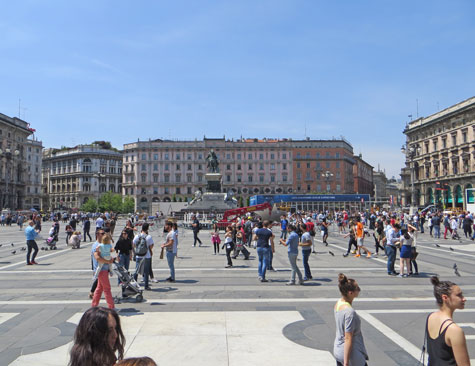
We commence with a visit to Milan's famous Gothic Cathedral.
This elaborate cathedral took six centuries to complete! It is the fourth largest in the world and the largest in Italy.
It was finally completed in the 19th century, when Napoleon Bonaparte ordered its completion. In his enthusiasm, he assured that all expenses would fall on the French treasurer, who would reimburse the Fabbrica for the real estate if it had to sell. Even though this reimbursement was never paid, it still meant that finally, within seven years, the cathedral was finished. The new architect Francesco Soave largely followed the original plan, but added some neo-Gothic details to the upper windows. As a form of thanksgiving, a statue of Napoleon was placed at the top of one of the spires.

Our next stop is the La Scala Opera House.
La Scala is a renowned opera house, originally known as the New Royal-Ducal Theatre at La Scala. Most of Italy's great operatic artists have appeared at La Scala during the past 200 years. Today, the theatre is still recognized as one of the leading ballet and opera theaters in the world.
La Scala was originally illuminated with eighty-four oil lamps and another thousand in the rest of the theater. To prevent the risk of fire, several rooms were filled with hundreds of water buckets. In time, oil lamps were replaced by gas lamps, these in turn were replaced by electric lights in 1883.
The original structure was renovated on 1907, when it was given its current layout with 2,800 seats. In 1943, during WWII, La Scala was severely damaged by bombing. It was rebuilt and reopened on May 11, 1946, with a memorable concert conducted by Arturo Toscanini - twice La Scala's principal conductor and an associate of the composers Giuseppe Verdi and Giacomo Puccini.
La Scala hosted the prima of many famous operas, and had a special relationship to with Verdi. For several years, however, Verdi did not allow his work to be played here, as some of his music had been modified (he said "corrupted") by the orchestra. This dispute originated in a disagreement over the production of his Giovanna d'Arco in 1845; however the composer later conducted his Requiem there on May 25, 1874, and in 1886 announced that La Scala would host the premiere of his opera Otello. The premiere of his last opera, Falstaff, was also given in the theater.
In 1982, the Filharmonica della Scala was established, drawing its members from the larger pool of musicians that comprise the Orchestra della Scala.

The Piazza del Duomo is named after, and dominated by the Milan Cathedral. The piazza marks the center of the city, both geographically and because of its importance from an artistic, cultural, and social point of view. Rectangular in shape and with an overall area of 183 square feet, the piazza contains some of the most important buildings in Milan, as well as some of the most prestigious commercial activities. It is by far the foremost tourist attraction of the city.
While the piazza was originally created in the 14th century and has been developing ever since, its overall plan, in its current form, is largely due to the architect Giuseppe Mengoni, and dates back to second half of the 19th century. The monumental buildings that mark its sides, with the main exception of the Duomo and the Royal Palace, were introduced by Mengoni's design; the most notable of Mengoni's additions to the piazza is the Galleria Vittorio Emanuele II arcade.

The Galleria Vittorio Emanuele II, or Gallery Victor Emmanuel II, is a covered double arcade formed of two glass-vaulted arcades at right angles intersecting in an octagon. Named after the first king of united Italy, it was originally designed in 1861 and built by Giuseppe Mengoni between 1865 and 1877.
The street is covered over by an arching glass and cast iron roof, a popular design for 19th century arcades such as the Burlington Arcade, London, which was the prototype for larger glazed shopping arcades, beginning with the Saint-Hubert Gallery in Brussels, the Passazh in St. Petersburg, the Galleria Umberto I in Naples, and the Budapest Galleria.
The central octagonal space is topped with a glass dome. The Milanese Galleria was larger in scale than its predecessors and was an important step int he evolution of the modern glazed and enclosed shopping mall, of which it was the direct progenitor. It has inspired the use of the term galleria for many other shopping arcades and malls. The use of the iron structure has inspired also the Eiffel Tower, in Paris.
The Galleria connects two of Milan's most famous landmarks - the Duomo and the La Scala Opera House, but the Galleria is a landmark in its own right. It is often called the "living room of Milan", enhanced by the elegance of some of Milan's finest stores.
No comments:
Post a Comment